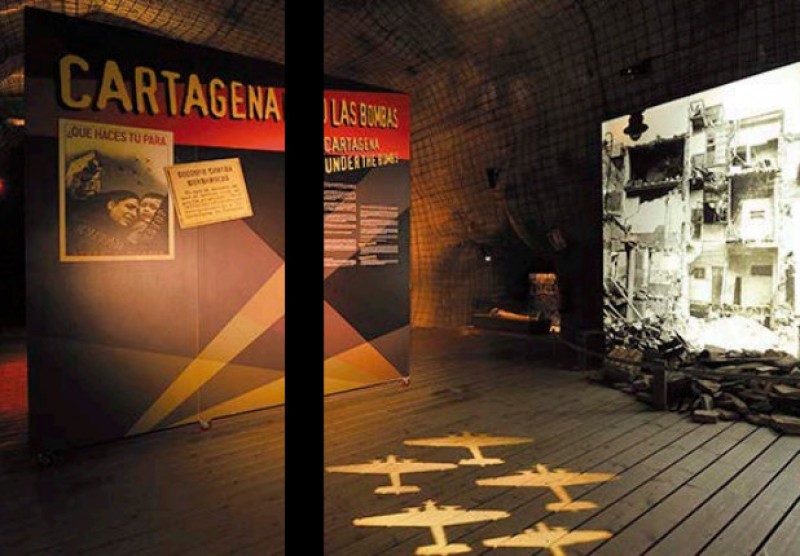- Region
- Vega baja
- Marina Alta
- Marina Baixa
- Alicante
- Baix Vinalopo
- Alto & Mitja Vinalopo
-
ALL TOWNS
- ALICANTE TOWNS
- Albatera
- Alfaz Del Pi
- Alicante City
- Alcoy
- Almoradi
- Benitatxell
- Bigastro
- Benferri
- Benidorm
- Calosa de Segura
- Calpe
- Catral
- Costa Blanca
- Cox
- Daya Vieja
- Denia
- Elche
- Elda
- Granja de Rocamora
- Guardamar del Segura
- Jacarilla
- Los Montesinos
- Orihuela
- Pedreguer
- Pilar de Horadada
- Playa Flamenca
- Quesada
- Rafal
- Redovan
- Rojales
- San Isidro
- Torrevieja
- Comunidad Valenciana
The Civil War air raid shelter museum in Cartagena
The Refugio Museo de la Guerra Civil in the centre of Cartagena
Looking at the serenity and beauty of the port in Cartagena today it can be hard to envisage the destruction that the city suffered during the years of the Spanish Civil War between 1936 and 1939.
This is still a time that many people prefer to forget, and interested visitors will often be met with silence when asking questions about the conflict, an episode in history from which the pain and division caused throughout Spanish society and within individual families is still raw today in some cases. Although Spain has been openly discussing the Civil War to a greater extent since the introduction of the Historical Memory Law in 2007, the controversy and divisions do not lie far below the surface, as was made abundantly clear in 2019 when the mortal remains of General Franco were disinterred from his monumental burial site of the Valle de los Caídos (Valley of the Fallen).
As a key port and munitions production centre Cartagena suffered severely during the war and was bombed mercilessly; the museum in the old air raid shelter keeps the memory of that suffering alive and attempts to explain to visitors what happened in Cartagena during that tumultuous period.
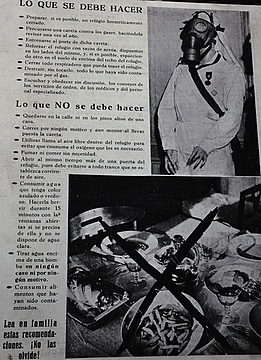 The Civil war started on 18th July 1936, when a sector of the army launched a military coup following a period of economic and social unrest, agitated by massive economic recession. Even though Cartagena was in the grip of economic misery following the sharp downturn in the mining activity industry which had rebuilt the city following the civil unrest of the 1870s, the city remained loyal to the government and became a vital Republican stronghold: it was home to the Republican fleet and a disembarkation point for vital military supplies and food, as well as being a major munitions manufacturing centre.
The Civil war started on 18th July 1936, when a sector of the army launched a military coup following a period of economic and social unrest, agitated by massive economic recession. Even though Cartagena was in the grip of economic misery following the sharp downturn in the mining activity industry which had rebuilt the city following the civil unrest of the 1870s, the city remained loyal to the government and became a vital Republican stronghold: it was home to the Republican fleet and a disembarkation point for vital military supplies and food, as well as being a major munitions manufacturing centre.
This, of course, made it a target for Nationalist forces, but the military defences installed around the city, which had been at the centre of many armed conflicts throughout the previous 2,000 years, made it a difficult target to capture, the easiest route to breaking its resolution and defences being via the air.
A sophisticated battery of 44 defence elements protected coastline close to the city with the mighty Vickers guns, the most technologically advanced of their time, some of which can still be seen at Cabo Tiñoso near La Azohía and other batteries. These made a direct attack on Cartagena from the sea or on land a dangerous and foolhardy option, whereas although anti-aircraft guns managed to force planes to fly at greater heights, limiting the accuracy of the bombers, the sky offered a far more productive line of attack. Cartagena was targeted on dozens of occasions during the conflict, the worst night of all being the "four-hour bombing" of 25th November 1936, when a rain of 250-kilo devices blasted the Naval Arsenal and the railway station. This was followed by hundreds of 1-kilo incendiary devices which started fires throughout the city, causing widespread damage.
Cartagena was one of the last cities taken by the Nationalist troops, holding out until the Fourth Navarre Division entered the city on 31st March 1939. This ended three years of hardship and destruction including episodes such as the sinking of the ship Castillo Olite on 7th March 1939, in which over 1,400 men died.
(Click here for more about the history of Cartagena.)
The shelter in Calle Gisbert and the museum
In the face of the attacks from the air, as was to be the case in other European nations during the Second World War, the inhabitants sought refuge underground, and this structure in Calle Gisbert offered shelter for up to 5,500 people.
Construction of the shelter began in 1937 with the support of the central government since the Town Hall lacked the ability to finance it, and there were 20 access points and a First Aid room. Some parts were not completed, and only some of the original galleries of the refuge are open to the public.
The museum, built within the original structure of the shelter in 2001, gives an insight into the daily lives of the people who lived through this period, and how they survived.
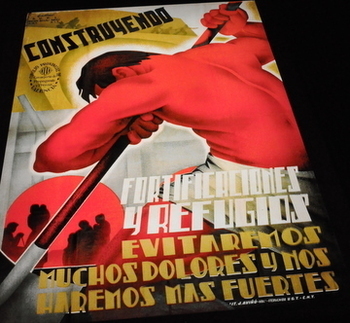 Little everyday details abound and catch the eye, such as a notice which bans shops from increasing the prices of their goods or a sign showing graphically what people should and should not do in the event of an air raid. Alongside them are “glorious”, almost Stalin-esque posters calling on the menfolk of Cartagena to take up their shovels and build air raid shelters, and the whole collection brings the period alive to present-day visitors.
Little everyday details abound and catch the eye, such as a notice which bans shops from increasing the prices of their goods or a sign showing graphically what people should and should not do in the event of an air raid. Alongside them are “glorious”, almost Stalin-esque posters calling on the menfolk of Cartagena to take up their shovels and build air raid shelters, and the whole collection brings the period alive to present-day visitors.
Separate tableaux deal with topics such as how children went to school, how they entertained themselves and what they ate: make sure you press the button to switch the radio on!
One particularly moving feature is the real-life accounts of the citizens themselves. All of these are translated into English and it is worth taking a while to listen to them as they include some real gems. One example is the recollections of an old man who talked with a cheeky grin about how he and his comrades fooled the Nationalist forces by filling a field with poles outside Cartagena and rigging up lights on them. When warning of an aircraft approach was received the townspeople would switch off the lights in Cartagena and light up the field, succeeding more than once in tricking the attackers into bombing a field in the middle of nowhere and thus saving lives and homes.
Unfortunately such ruses were not always successful, but strategies such as this probably help to account for the frequency with which Civil War explosives are still found today in the surrounding countryside: a selection of such projectiles can be seen in the military museum of Cartagena. armaments, head for the Museo Militar nearby which has an enormous collection.
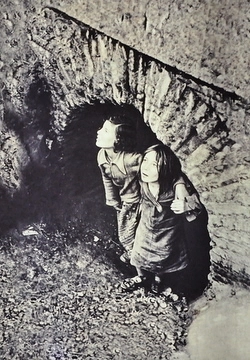 Another moving exhibit in the air raid shelter is the projection of photographs showing Cartagena before the war and after, illustrating graphically how so much of the city’s architectural heritage was lost forever.
Another moving exhibit in the air raid shelter is the projection of photographs showing Cartagena before the war and after, illustrating graphically how so much of the city’s architectural heritage was lost forever.
The museum tour includes four separate sections devoted to the following aspects of the Civil War in Cartagena:
Types of shelters and their construction – different types of shelter and the range of materials used to protect civilians.
Life in the Civil War - photographs, panels, first-hand accounts and recreations the changes brought about to daily life in Cartagena by the outbreak of war.
Passive defence - posters, information panels and objects used during the war illustrate the ways in which civilians were prepared for the fact that they would be exposed to attackers from the air, the first time this had been an important facet of armed conflict.
Active defence - the "Special Defence Against Aircraft" (DECA) unit was responsible for anti-aircraft artillery and floodlighting systems, warnings, alarms, communications and observation.
Cartagena under the bombs - real images offer a glimpse of the devastation suffered by Cartagena during the bombings.
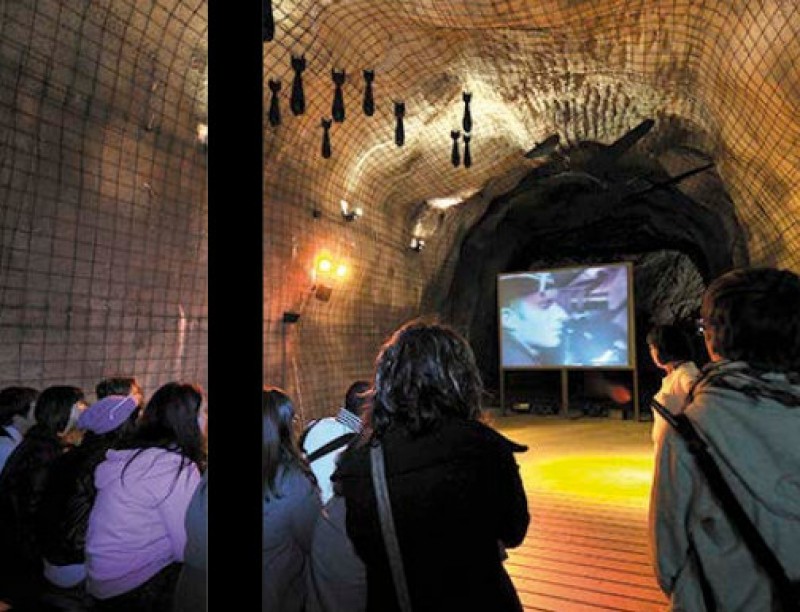
Opening hours
High season (1st July to 15th September)
Every day of the week from 10.00 to 20.00.
Mid season (15th March to 30th June and 16th September to 1st November)
Tuesday to Sunday 10.00 to 19.00 (open all week during Semana Santa).
Low season (2nd November to 14th March)
Tuesday to Sunday 10.00 to 17.30.
The museum closes on the holidays of 1st and 6th January and 25th December and opens only in the afternoons on the days preceding them.
Note: groups with prior reservations will be given preference at the entrance.
Admission Charges
Admission is priced at 3.50 euros, or a reduced rate of 2.50 euros for under-12s, students up to the age of 25, Carné Joven holders, the unemployed, pensioners, the disabled, families of at least 2 adults and 2 children and groups of 20 or more. Relevant documentation is required in order to justify the application of the reduced rate.
Entry is free of charge for children aged under 3.
Audioguides and guided tours
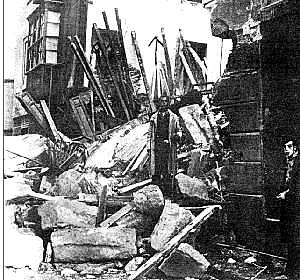 Audio guides are available at a cost of 2.50 euros and can be used to complete your visit in the order you like and taking as much time as you like. The guides are supplied in Spanish, English, French and Russian.
Audio guides are available at a cost of 2.50 euros and can be used to complete your visit in the order you like and taking as much time as you like. The guides are supplied in Spanish, English, French and Russian.
30-minute guided tours are offered in Spanish at 11.00 and 16.00 in the low season, 11.00, 12.30 and 17.00 in mid-season and 11.00, 12.00, 17.00 and 18.00 in high season (these timetables are subject to modification and interested visitors are advised to check beforehand). Priority will be given to pre-booked groups, so it is advisable to enquire in advance.
How to get there
The museum is located in Calle Gisbert close to the city and alongside the panoramic lift: see map below.
It may be possible to find free parking around the UPCT university buildings just to the east of the panoramic lift or in Calle Pez, at the bottom of the hill of Calle Gisbert. Alternatively, the easiest paying car park is the one on the seafront about 10 minutes’ walk away. Click for Cartagena carparks or if the vehicle driven is a campervan or high topped vehicle CLICK HERE for suitable parking.
Accessibility and services
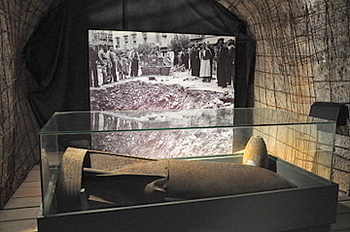 Access is via the Panoramic lift and presents no problem at all for wheelchair users. Once inside the floors are level and there are no steps, making this one of the best attractions in Cartagena for those with mobility issues.
Access is via the Panoramic lift and presents no problem at all for wheelchair users. Once inside the floors are level and there are no steps, making this one of the best attractions in Cartagena for those with mobility issues.
In addition, the following services are on offer at the museum for those with disabilities and impairments:
Adapted toilets.
Audio-visuals with sub-titles in English) and oral commentary in Spanish for people with visual and hearing disabilities.
Reduced admission fees for the disabled (see above).
Guide dogs are admitted with the corresponding accreditation.
The museum is equipped with vending machines selling soft drinks and snacks, and there is a small selection of gifts and souvenirs on sale.
For full information in English about the Cartagena municipality CLICK HERE
For full information about places to visit in Cartagena city CLICK HERE






